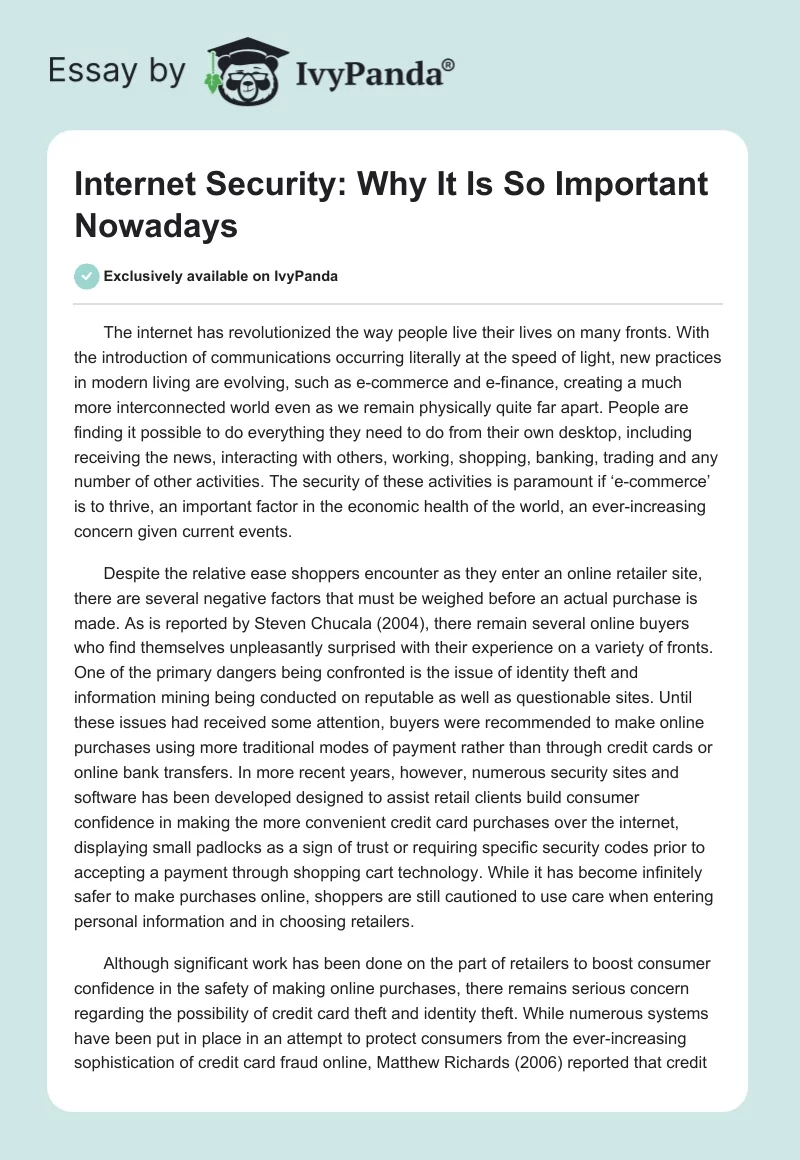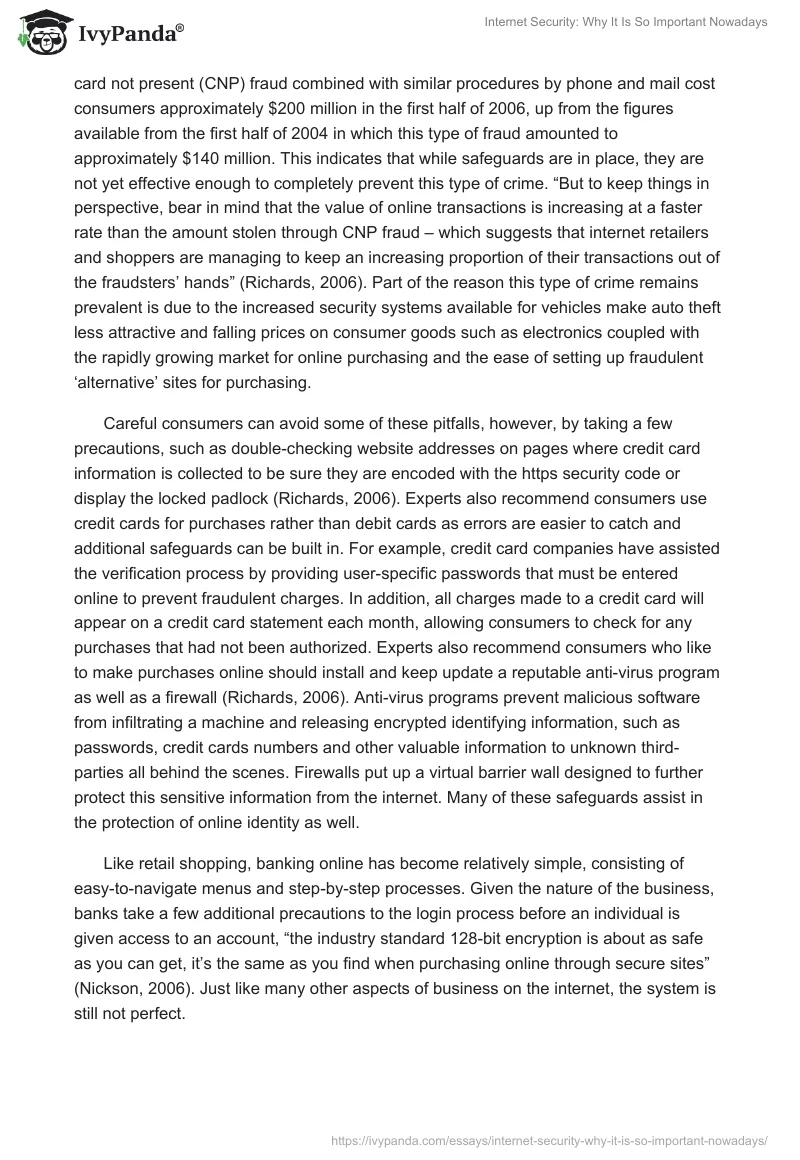The internet has revolutionized the way people live their lives on many fronts. With the introduction of communications occurring literally at the speed of light, new practices in modern living are evolving, such as e-commerce and e-finance, creating a much more interconnected world even as we remain physically quite far apart. People are finding it possible to do everything they need to do from their own desktop, including receiving the news, interacting with others, working, shopping, banking, trading and any number of other activities. The security of these activities is paramount if ‘e-commerce’ is to thrive, an important factor in the economic health of the world, an ever-increasing concern given current events.
Despite the relative ease shoppers encounter as they enter an online retailer site, there are several negative factors that must be weighed before an actual purchase is made. As is reported by Steven Chucala (2004), there remain several online buyers who find themselves unpleasantly surprised with their experience on a variety of fronts. One of the primary dangers being confronted is the issue of identity theft and information mining being conducted on reputable as well as questionable sites. Until these issues had received some attention, buyers were recommended to make online purchases using more traditional modes of payment rather than through credit cards or online bank transfers. In more recent years, however, numerous security sites and software has been developed designed to assist retail clients build consumer confidence in making the more convenient credit card purchases over the internet, displaying small padlocks as a sign of trust or requiring specific security codes prior to accepting a payment through shopping cart technology. While it has become infinitely safer to make purchases online, shoppers are still cautioned to use care when entering personal information and in choosing retailers.
Although significant work has been done on the part of retailers to boost consumer confidence in the safety of making online purchases, there remains serious concern regarding the possibility of credit card theft and identity theft. While numerous systems have been put in place in an attempt to protect consumers from the ever-increasing sophistication of credit card fraud online, Matthew Richards (2006) reported that credit card not present (CNP) fraud combined with similar procedures by phone and mail cost consumers approximately $200 million in the first half of 2006, up from the figures available from the first half of 2004 in which this type of fraud amounted to approximately $140 million. This indicates that while safeguards are in place, they are not yet effective enough to completely prevent this type of crime. “But to keep things in perspective, bear in mind that the value of online transactions is increasing at a faster rate than the amount stolen through CNP fraud – which suggests that internet retailers and shoppers are managing to keep an increasing proportion of their transactions out of the fraudsters’ hands” (Richards, 2006). Part of the reason this type of crime remains prevalent is due to the increased security systems available for vehicles make auto theft less attractive and falling prices on consumer goods such as electronics coupled with the rapidly growing market for online purchasing and the ease of setting up fraudulent ‘alternative’ sites for purchasing.
Careful consumers can avoid some of these pitfalls, however, by taking a few precautions, such as double-checking website addresses on pages where credit card information is collected to be sure they are encoded with the https security code or display the locked padlock (Richards, 2006). Experts also recommend consumers use credit cards for purchases rather than debit cards as errors are easier to catch and additional safeguards can be built in. For example, credit card companies have assisted the verification process by providing user-specific passwords that must be entered online to prevent fraudulent charges. In addition, all charges made to a credit card will appear on a credit card statement each month, allowing consumers to check for any purchases that had not been authorized. Experts also recommend consumers who like to make purchases online should install and keep update a reputable anti-virus program as well as a firewall (Richards, 2006). Anti-virus programs prevent malicious software from infiltrating a machine and releasing encrypted identifying information, such as passwords, credit cards numbers and other valuable information to unknown third-parties all behind the scenes. Firewalls put up a virtual barrier wall designed to further protect this sensitive information from the internet. Many of these safeguards assist in the protection of online identity as well.
Like retail shopping, banking online has become relatively simple, consisting of easy-to-navigate menus and step-by-step processes. Given the nature of the business, banks take a few additional precautions to the login process before an individual is given access to an account, “the industry standard 128-bit encryption is about as safe as you can get, it’s the same as you find when purchasing online through secure sites” (Nickson, 2006). Just like many other aspects of business on the internet, the system is still not perfect.
Although many advances have been made to protect the identity of online bankers and traders as well as to secure their accounts and investments, online fraud continues to be a problem that places consumers’ money and investments at significant risk. (Francis & Gilmore, 2006). A great deal of these scams are perpetrated through what is commonly labeled ‘phishing’ rather than technical glitches in the banking security systems, highlighting the need for online consumers to educate themselves in how best to protect their finances when conducting business online. “In September 2003, the Federal Trade Commission reported that 9.9 million U.S. residents have been victims of identify theft during the past year, costing businesses and financial institutions $48 billion and consumers $5 billion in out-of-pocket expenses” (Kay, 2004).
‘Phishing’ is not necessarily a new approach to fraud, but it has a new method of delivery, particularly in an online user’s email inbox. These messages are designed to give the impression that they come from legitimate businesses that the user is likely to have official business with. These businesses could be banks, such as Citibank, online organizations, such as eBay or PayPal, internet service providers or any number of online retailers. To complete this impression, the messages typically incorporate corporate logos and business-type formats that lend an extra measure of authenticity to the message. To gain the information criminals need to steal an identity or to gain access to online accounts, these letters usually indicate that the company featured is doing some sort of auditing or account checking procedure and requests the recipient of the letter to verify certain facts about their accounts, including account numbers, passwords, credit card numbers, social security numbers, date of birth or mother’s maiden names – in short, all of the information one would need to make a purchase without actually having a credit card in hand.
For many of these scams, an internet link is provided going to a similarly official-looking site that provides appropriate forms to be filled out by the consumer, thereby directly informing criminals of the information they have requested. “Because these emails look so official, up to 20 percent of unsuspecting recipients may respond to them, resulting in financial losses, identity theft and other fraudulent activity against them” (Kay, 2004). To avoid these types of problems, most companies, even before ‘phishing’ became widely known among the general populace, had already adopted policies in which this information was not requested via email links to their websites. When identifying information is required, most companies will make the request that customers visit their web sites independently so as to assure secure connections.
While banks have little to no control over the rates at which online bankers use or update security features for their own personal computers or whether or not they respond to phishing messages arriving in their email boxes, it has been established that much can be done by these institutions to reduce the ability of criminals to create overlay sites for collecting the information they seek. The internet security firm Heise illustrated to several banks the relative ease with which someone with some knowledge and skill could overlay the websites of their institutions with rogue frames served from websites controlled and operated by the fraudsters. (Leyden, 2006). “Frame spoofing attacks can be thwarted providing users are using up to date browser software, but the cross-site scripting attacks it demonstrated can’t be addressed by client-side security updates, according to Heise. Both types of attacks require a modicum of skill to carry out, but are far from difficult (Leyden, 2006). Several of the high street banks did not have these same security risks, using a specific JavaScript code to ensure the frameset was valid regardless of the user’s browser generation, encouraging many of the at-risk banks to make changes quickly to ensure similar security for their customers. The eagerness with which many of these banks undertook the task of updating their security testifies to the interests of the banking community to ensure consumer confidence, yet the risks also highlight the importance of keeping consumers educated regarding what they can do on their own systems to ensure their personal online safety.
Based upon its level of use in current society, it is safe to say that the internet will become even more integrated into everyday life of individuals throughout the world in the years to come. Industries will continue to evolve as more and more people find means of living their lives in more integrated environments. However, as the internet gains in importance and evolves into more usable, user-defined structures, it will become more and more a target for criminals. However, increasing attention on security will ensure steady growth of internet banking and consumer purchasing.
References
Chucala, Steven. (October, 2004). “Internet Buyer Beware.” Soldiers Magazine.
Francis, Clare & Gilmore, Grainne. (2006). “Online Banking Fraud on the Rise.” Times Online. Web.
Kay, Russell. (2004). “QuickStudy: Phishing” Computer World. Web.
Leyden, John. (2006). “UK Banking Websites’ Security Slammed.” The Register.
Nickson, Chris. (2006). “Shouldn’t You be Banking Online?” Digital Trends. Web.
Richards, Matthew. (2006). “Online Shopping.” The Financial Times.


